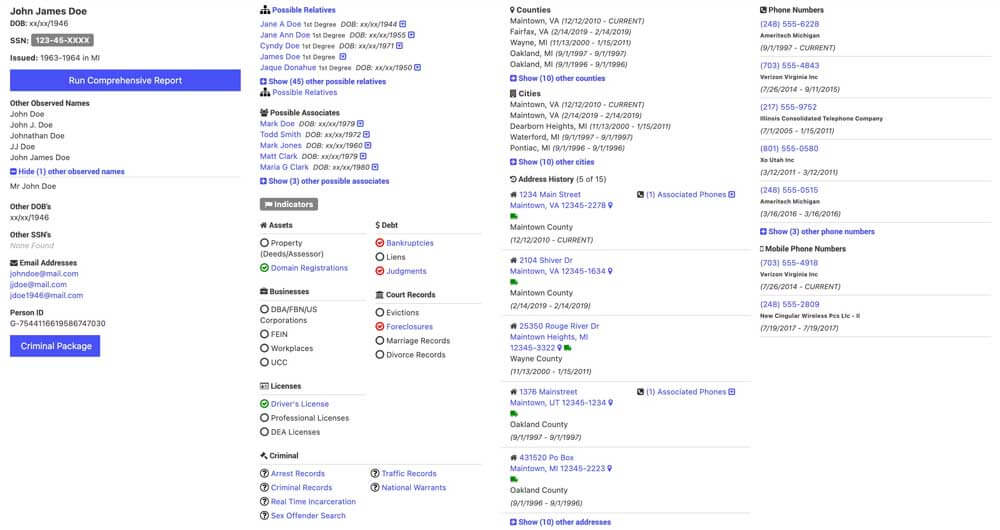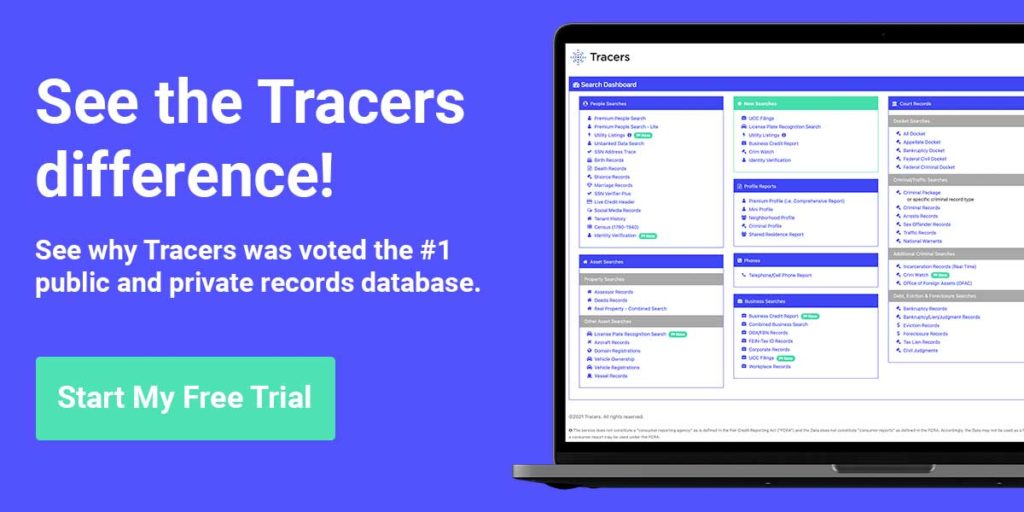Estimated reading time: 10 minutes
When someone “skips town,” it’s often because others are looking for them. Sometimes, the individual knows a summons is on the way, or they’re a key witness in an ongoing investigation, or they may even owe too many people money. Other times, an individual may not be hiding, but they are just difficult to find because of outdated records or a lack of information. Regardless of whether someone is going off-grid intentionally or just trying to remain private, you need to be able to find them if the situation requires it — and finding these individuals is called skip tracing.
What is skip tracing?
Skip tracing definition: Skip tracing is the process of tracking down people who are particularly hard to find, whether they’re persons-of-interest, fact witnesses, debtors, or other individuals. This definition comes from an individual being difficult to find (aka, the “skip”) and the process of finding them (tracing), and skip tracing these individuals often requires more information than basic address and contact information.
Other details that can typically be useful to skip tracers include:
- Property records.
- Credit score details.
- Criminal history.
- Legal and court history.
- Tax and other financial details.
- Known travel records.
- Social media accounts.
Video Transcription:
When someone “skips town,” oftentimes it’s because other people are looking for them. Sometimes the individual knows a summons is on the way or they are a key witness in an ongoing investigation, or maybe they just owe too many people a lot of money. Other times, they aren’t hiding but just aren’t that easy to find. Whether someone is going off-grid on purpose or just protecting their privacy, the fact is people need to be found.
The term for this is skip tracing. By definition, skip tracing is a process of finding and tracking down persons of interest, fact witnesses, and other individuals.
Skip tracing often includes more than uncovering a simple location and contact data, like a phone number or email address. Other details typically sought by skip tracers are things like property and address information, criminal background, legal and court history, even social media accounts.
Tracking people via skip tracing is used by professionals in a number of different industries for multiple purposes, including law firms,
private investigators, debt collectors, and real estate investors.
If you’re interested in getting started with skip tracing, visit tracers.com/skip. Tracers is the number one trusted cloud-based investigative research software and have been helping thousands of customers across dozens of industries for over 20 years. There is no risk and your first $100 in searches is free. Visit tracers.com/skip to learn more, and happy searching.
Who can use skip tracing?
Skip tracing is incredibly important to a wide variety of different industries. Legal professionals, private investigators, and law enforcement agents can use skip tracing to find individuals that may be involved in or have important information about a specific case, as well as bounty hunters looking for people who have jumped bail. People working in collections or repossession, like collection agencies, can also use skip tracing to find debtors.
What does skip tracing solve?
Skip tracing can be beneficial in any situation in which you need to find an individual, whether it’s to track down someone involved in a crime, locate a potential witness, or find a debtor for collection. Here are a few common examples of skip tracing use cases in different industries:
- Locating people for a case:: Legal professionals, private investigators, and law enforcement agents can use skip tracing to locate witnesses or persons-of-interest in a criminal investigation, cold case investigation, or fraud investigation. People involved in an investigation or crime often have a greater incentive to hide, so finding these people requires gaining access to the most-up-date data available as well as past records that may provide valuable information about an individual’s current whereabouts.
- Finding people who have skipped court: When someone doesn’t show up for court, it’s considered a “skip,” and bounty hunters are brought in. Bounty hunters can use skip tracing to track these individuals down and turn them in for their appointments.
- Locating debtors to collect on debt: Debt collectors and debt buyers need to be able to skip trace individuals in order to collect on debt for in-house collections or debt buying, but changes of address and phone numbers, as well as current debt collection regulation, can make skip tracing and achieving right-party contact for debt collection difficult. Debt collectors need the best skip tracing tools in order to find up-to-date location and contact information to reach someone in a legal and efficient way.
Skip tracing isn’t only used to find witnesses, persons-of-interest, bail jumpers, or debtors — it can be useful in any situation in which you’re trying to locate a certain individual. Here are a few of the other use cases for skip tracing:
- Locating potential home sellers or buyers for real estate: Real estate agents and investors can use REI skip tracing to find potential home sellers, like an owner of a property that is unoccupied or ready to be sold, so you can add new homes to the real estate market. Real estate agents also may want to skip trace property owners to build a list of emails and phone numbers for their portfolio of buyers and sellers.
- Finding people for legal research: Law firms may want to skip trace people involved in a business in order to perform legal research for due diligence. a. Or, you may want to find the whereabouts of the next of kin for estate planning and probate law. In both of these situations, skip tracing can help you find the people you need to perform effective legal research and build your case. .
- Finding family (and friends): Genealogists, adopted children looking for their birth parents, or people looking to organize a reunion can use skip tracing to build a web of connections and find people who have gone off-the-grid.
How can I do a skip trace on my own?
If you’re looking to skip trace an individual, you need to be able to turn very little information into the actionable intelligence you need to find that person. While finding people with not that much information is challenging, even for a professional skip tracer, there are a number of skip tracing tools you can use to get the necessary data. With just a name or last known location, can search a variety of different places to find more information. Here are some search engines for skip tracing:
- Google: Most people think that Google has all the answers. But the truth is when people are trying to hide or do not want to be found… they their contact information probably isn’t going to show up in a Google Search. Yes, you can try to search for someone’s name or hit the “Images” tab and you may be able to find the person you’re looking for (if you know what they look like) but if someone is trying to hide, this information will most likley be out of date. Click the image of the person and you’ll be taken to the site that hosts the picture — which can be used to find even more information about that individual, like a business they’re associated with.

- Social media: Type a name into Facebook or LinkedIn and you’ll probably find multiple profiles. It may take some time, but if the person you’re looking for is on that social network, you can find them by manually through social profiles.
- People finders: A number of sites find limited data about individuals for you. There is often some sort of one-time fee for each individual, but people finder tools can provide you with information about a person’s location, like their current address.
- Genealogy sites: Family tree enthusiasts aren’t the only people using genealogy sites. These tools are great for skip tracing to build a web of connections , but they often only provide readily public records.
- Tracers: Tracers is a public and private records database that pulls over 42 billion public and private records from thousands of sources. In Tracers, you can find information that all of the above searches provide in one centralized platform PLUS private records data that is not available in other solutions. For example, Tracers pulls in information from utility listings and alternatative data sources which has contact information for people that you can’t find with any free software or search engine.

How can I perform batch skip tracing?
Batch skip tracing is the act of finding large amounts of individuals on a regular basis. Law firms, debt collectors, PIs all need to use batch skip tracing to find large numbers of individuals for their jobs. These people may gather bulk information for batch skip tracing by manually performing individual searches, or they may hire a third-party to batch skip trace people for them. . However, if you’re looking to perform batch skip tracing quickly and more cost-effectively, you can use a software like Tracers with batch processing options. Batch skip tracing in a public and private records database allows you to run high-volume searches at once so you can track down many individuals in less time, and without paying for each individual search.
Best skip tracing services: “Tracers”
When you need an in-depth workup on an individual, want to track behavior for certain amounts of time or have multiple people to find — a skip tracer is sometimes needed.
Tracers are professional skip tracers who make it their job to find individuals. Again, these are primarily bounty hunters and private investigators. In the past, law firms primarily relied on private investigators to do the tough work of finding and keeping tabs on persons-of-interest.
These tracers would then hit the pavement and pull out the phone book. Make calls to nearest-of-kin, physically drive to places and find documents. But tracers today don’t employ these methods nearly as much.
What do I need to get started with skip tracing?
Nowadays, people can rely heavily on technology, like a public and private records database, to do most of the heavy lifting in skip tracing. The best skip tracing tools in a public and private records database will automatically pull a wide variety of different records from multiple sources, including multiple credit header bureaus, unbanked sources, and alternative data sources that provide the utility history by address, to provide you the comprehensive information you need to skip trace any individual.
A few of the key skip tracing searches available in a public and private records database include:
- A premium people search, which provides you with personal data you like names, social security numbers, telephone numbers, known associates, neighbors, and relatives of an individual so you can build a web of connections and glean insight from these connections into a person’s possible whereabouts.
- Business records, specifically workplace records, that provide you with an employee’s name, recent employer, start date, business address, and more so you can skip trace an individual to their place of work.
- A social media search, which pulls information from a variety of social media platforms and websites into one easy-to-read report. This allows you to find key pieces of evidence about a person’s locations in social media more quickly and reduces the likelihood of searching for the wrong person.
- Address history search, license plate recognition system, and utility listings data to help you determine someone’s living and travel patterns so you can make educated guesses as to where they may be currently, even if you can’t find their current address with a basic people search.
- Individual searches, batch processing, and API integration so you can collect data in the best way for you and customize the results to fit your specific needs.
Whether you’re looking to skip trace one individual or perform batch skip tracing, a public and private records database like Tracers can provide you with the skip tracing services you need to uncover important information about an individual’s possible whereabouts. Tracers cloud-based functionality allows you to access all data you need from any device, anywhere you want. And, with a variety of different kinds of searches and billions of records, you can avoid using a variety of different skip tracing services and instead you get all the information you need in one centralized platform. Ready to see how a public and private records database can help you with skip tracing? Get started with Tracers today.



4 thoughts on “What is Skip Tracing?”
Comments are closed.